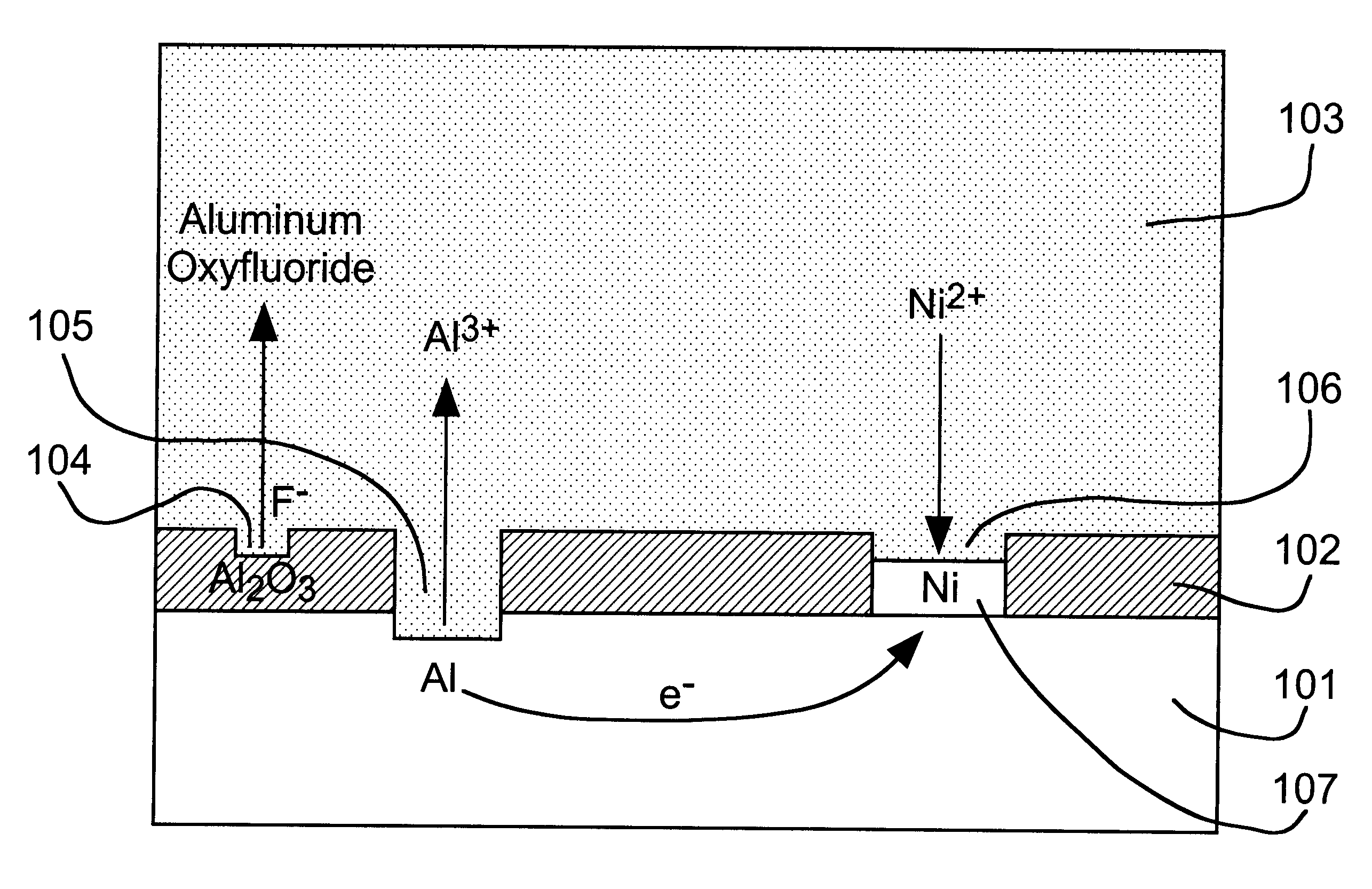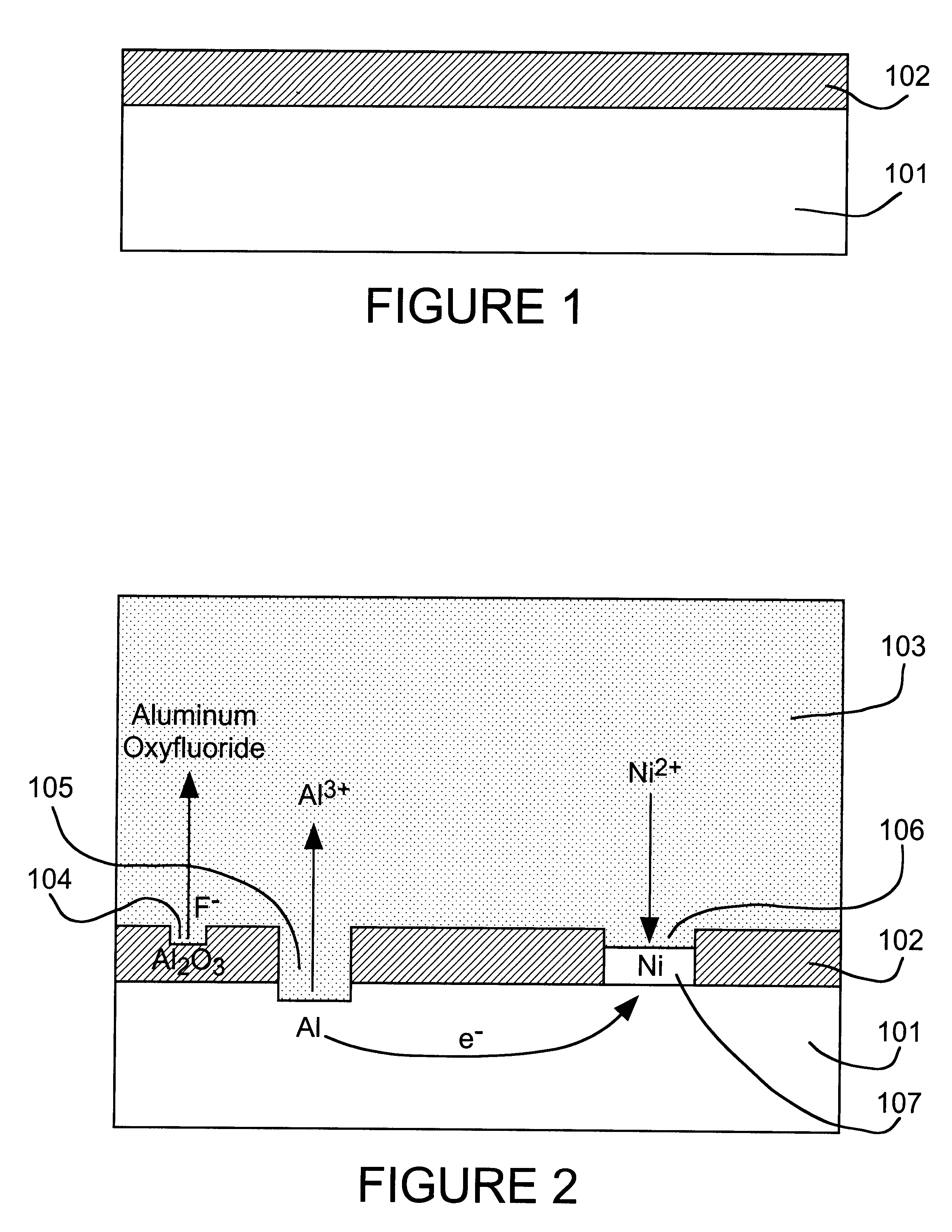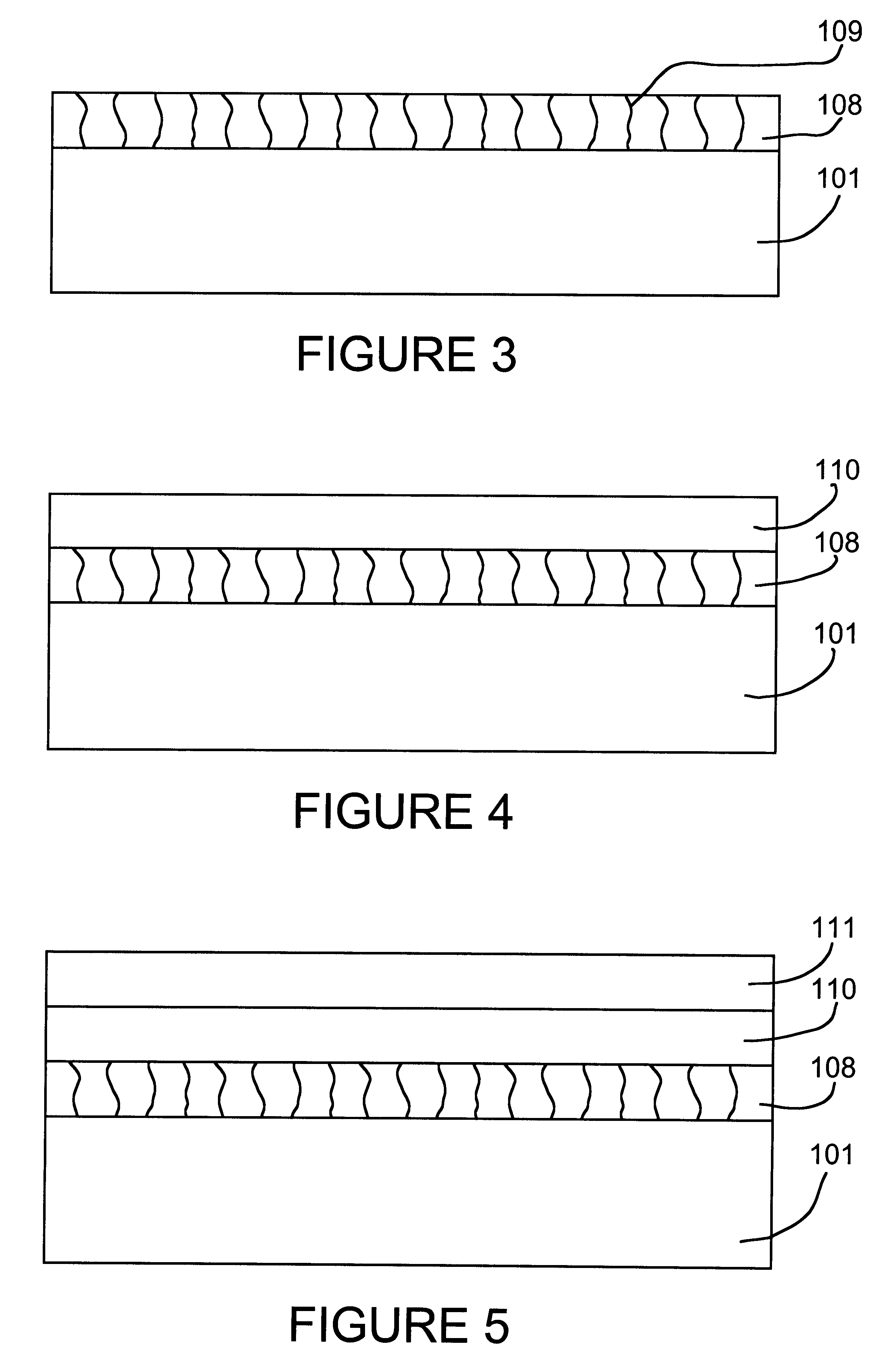Aluminum is widely used for circuitry patterns on
integrated circuit (IC) chips but is very difficult be directly solder because it is a very reactive metal that forms a thick oxide layer, which prevents direct contact between the solder and the
aluminum metal.
This thick oxide is recalcitrant in that it is difficult to remove and reforms almost instantaneously under ambient conditions.
Wire bonding imposes significant limitations for microelectronic applications.
Since the bonds are made one at a time, the process is relatively slow and expensive compared to
soldering, which can form thousands of connections almost simultaneously.
The expense of the gold wire adds significantly to the costs.
Another important drawback is the
inductance of the gold wires themselves, which becomes appreciable at high
signal frequencies and limits device switching times or
clock speeds.
Furthermore, because of wire length and routing issues, wire bonds are not practical for connecting to the area arrays, e.g., ball grid arrays, that are becoming commonplace as the sizes of IC chips decrease and
clock speeds and the number of input / output (I / O) connections increases.
Such vacuum
processing is inherently very expensive and also requires
photoresist masking to enable lift-off of metal deposited in non-pad areas, or to confine subsequently electrodeposited metal
layers to the pads.
A significant concern for
electroplating processes is non-uniformity of the plated
layers, especially overplating of isolated pads and underplating of those close together.
However,
copper can migrate rapidly in aluminum and degrade both the mechanical properties of the aluminum and the electronic performance of the underlying
silicon.
Furthermore, copper displacement coatings on aluminum tend to be porous and poorly adherent, and can produce rapid
corrosion of the aluminum via galvanic action, so that they are only moderately effective for protecting aluminum against corrosion or serving as the basis for a corrosion-resistant
overlayer.
This process for indirect displacement plating of
nickel on aluminum via zincating has major drawbacks, especially for plating pads on IC chips.
One fundamental problem is that
hydroxide ion in the strongly alkaline zincating solution aggressively attacks the aluminum itself with evolution of
hydrogen gas (2Al+2OH.sup.- +2H.sub.2 O.fwdarw.2AlO.sub.2.sup.-+3H.sub.2).
In addition, the
zinc deposit is porous and non-uniform since the displacement reaction must occur rapidly while
dissolution and
hydrogen evolution are also occurring on both the bare
aluminum substrate and the
zinc metal deposit.
Double zincating consumes even more aluminum and only partially improves the
zinc deposit quality.
Furthermore, poor adhesion of the nickel deposit results if the zinc deposit is not completely removed by
dissolution in the
electroless nickel bath, which is difficult to ensure.
Another fundamental problem with the overall process is the use of an
electroless nickel bath for both the nickel / zinc displacement and
electroless deposition reactions, which have dichotomous requirements.
In particular, strongly complexed
nickel ions should provide better quality deposits by slowing the displacement reaction to a moderate rate, but would not be reducible by the mild reducing agents needed to avoid extraneous
electroless deposition.
It is not surprising that such a dynamic process with many uncontrollable variables has not produced consistent results in production use.
A method for direct displacement plating of nickel on aluminum might be expected to yield the high quality deposits needed for a practical IC
chip bumping process but has not been developed previously despite the long standing need.
One reason is that the
hydroxide ion employed in the prior art to remove the aluminum
surface oxide in the zincating process cannot be used in a nickel displacement plating solution since it would precipitate nickel
hydroxide, which is highly insoluble.
Note that nickel forms amine complexes in
aqueous solution that are stable in the presence of hydroxide
ion but these do not allow nickel displacement plating on aluminum.
Degradation in wire bondability of aluminum pads is a particular problem for low-volume IC
chip users who must purchase in volume to obtain a good price and then store chips for later use.
Nonetheless, appreciable amounts of water may be present without significantly reducing the benefit provided by the nonaqueous
solvent.
Excessively fast displacement plating results in porous, poorly-adherent deposits.
Under these conditions, activator consumption in the oxide
dissolution process reduces the concentration of activator species at the surface, especially within pores in the oxide layer where substrate
attack by the activator occurs.
This approach involving use of a low level of solution agitation is counter to the teachings of the prior art since plating baths generally require vigorous solution agitation to avoid depletion of essential bath constituents at the part surface.
A thick
surface oxide layer 102, which can result from long storage or previous
processing, may be difficult to penetrate so that a sufficiently strong wire bond cannot be formed under normal
wire bonding conditions.
1) a
solvent, either nonaqueous, aqueous or mixtures thereof. Preferred solvents include dimethylsulfoxide (DMSO),
ethylene glycol (EG), and other
organic liquids. Water reacts with bare aluminum and other reactive metals with evolution of
hydrogen gas, which results in excessive consumption of substrate material and may degrade the quality of the displacement coating. Deposits obtained from purely aqueous solutions may be acceptable but may not be as adherent, at least in some cases, since a slight amount of material can be removed by
rubbing. Some anions containing
fluorine, e.g., SiF.sub.6.sup.2-, are also unstable in aqueous solutions, which would limit the choice of activator species. In addition, the preferred DMSO and EG nonaqueous solvents are less volatile than water so that higher temperatures can be used to accelerate the rates of the oxide dissolution and
displacement reactions. On the other hand, water may be present in appreciable amounts in nonaqueous systems without degrading the quality of displacement coating obtained. Insensitivity to the presence of water is highly beneficial for a practical process.
2) a
fluoride activator species to dissolve surface oxide layer 102 so that the displacement reaction can occur at a practical rate.
Hydroxide is used as an activator for the zincating process of the prior art but has been found to be too aggressive and difficult to control, and typically cannot be used in
anhydrous nonaqueous solvents.
Hydroxide usually cannot be used for nickel displacement plating since Ni(OH).sub.2 is highly insoluble and would precipitate from most solutions.
Nickel amine complexes are stable in the presence of hydroxide ion but do not displacement plate nickel on aluminum. The
fluoride activator of the present invention can be added as a simple
fluoride salt or in the form of an complex fluoroanion, which yields fluoride by dissociation. Based on the rate of the nickel displacement reaction on aluminum in DMSO, we have found the activity of fluoride to decrease in the order: F.sup.- >AlF.sub.6.sup.3->SiF.sub.6.sup.2->>PF.sub.6.sup.-, BF.sub.4.sup.- for various anion sources.
3) ions of the relatively stable metal to be deposited by displacement plating on the reactive metal.
Nickel,
cobalt and
palladium are relatively oxidation-resistant and can be used as solderable finishes for
electronics applications. Displacement coatings of all three metals have been applied to aluminum substrates by the displacement process of the present invention. A thin
overlayer of
noble metal, e.g., gold, may be used to preserve the
solderability and wire bondability of nickel and
cobalt coatings. The preferred solution anions are halides (
chloride,
bromide and
iodide) or pseudohalides (
cyanide and
thiocyanate), which tend to beneficially inhibit the displacement process by complexing the stable metal ions and adsorbing on the metal surface. Of these,
chloride and
bromide are most useful, since complexes of other
halide and pseudohalide anions tend to lack sufficient
solubility or stability, or form overly stable complexes that would slow the displacement reaction excessively.
This is particularly true when surface oxide 102 has become excessively thick, nonuniform or contaminated by prior
processing, long storage and / or
exposure to corrosive or contaminated environments.
Pretreatment of aluminum pads on IC chips in this solution at 50.degree. C. for 5 to 10 seconds yielded more uniform displacement coatings for chip batches that tended to give poor results, whereas pretreatment in this solution was ineffective at
room temperature and resulted in excessive
etching of the aluminum at 100.degree. C.
This is particularly important for high volume production processes for which buildup of high concentrations of contaminants can interfere with the functioning of the treatment solutions.
Water present in such nonaqueous solvents is apparently not detrimental but use of pure water as the solvent does not produce the best displacement coatings.
The reactivity of the activator must be sufficiently high that the rate-limiting oxide dissolution step is fast enough for a practical process, but not so high that excessive substrate dissolution occurs through pores in the oxide.
In addition, the inherent reactivity of the stable metal ions must be high enough that the displacement reaction keeps up with the oxide
dissolution reaction, but must not be so high that the displacement process is uncontrolled and produces powdery deposits.
In principle, laminar
solution flow or part movement parallel to the surface could enhance solution
mass transport to the surface without perturbing the solution in pores but can be difficult to attain uniformly over the part surface and to maintain constant with time.
 Login to View More
Login to View More 


